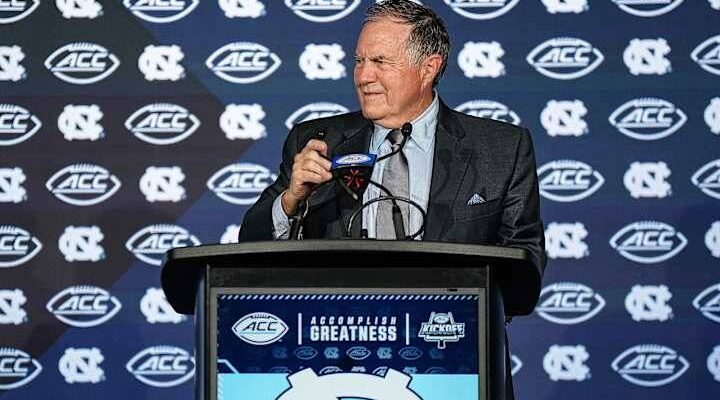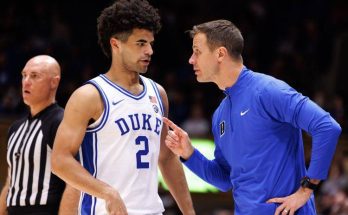He took over the most illustrious program in college basketball history at the age of 35, replacing Coach K, a living legend. Now, following 89 victories and several tournament runs,
He took over the most illustrious program in college basketball history at the age of 35, replacing Coach K, a living legend. Now, following 89 victories and several tournament runs, his tenure is no longer seen as an apprenticeship or a transitional period. Jon Scheyer has cemented himself as the present and future of Duke basketball, steering the program not with imitation, but with quiet evolution. From the very start, the weight on his shoulders was immense. Coach Mike Krzyzewski, known simply as “Coach K,” was not just any coach—he was the most decorated, most respected, and perhaps the most influential figure the sport had ever known. Replacing him was never going to be about simply maintaining wins and appearances. It was about preserving a culture, reimagining an identity, and keeping Duke at the center of the college basketball universe. Scheyer knew this when he accepted the position in 2021, and now, several seasons in, his performance speaks volumes.
Jon Scheyer was no stranger to Duke. As a player, he was a standout guard, a captain, and a national champion. His basketball IQ, competitive fire, and calm leadership had been trademarks even then. After a brief stint in professional basketball, he returned to Durham to join the coaching staff, rising through the ranks under Krzyzewski’s guidance. That apprenticeship proved invaluable. By the time he was named head coach-in-waiting, he had already become deeply embedded in Duke’s recruiting strategies, player development processes, and game planning philosophies. He didn’t just understand the Duke standard—he had helped uphold and shape it.
But when the day finally came to step into Krzyzewski’s shoes, theory met reality. Replacing a legend is never a linear path. Fans, alumni, analysts, and even players would inevitably draw comparisons. Every in-game decision, every loss, and every high-profile recruit lost to another school would invite scrutiny. Scheyer’s calm demeanor and steady vision, however, prevented the program from veering off course. He didn’t try to be a carbon copy of Coach K. He didn’t deliver fire-and-brimstone speeches or cultivate an authoritarian presence. Instead, he modernized the role—opting for a more player-centric approach, empowering assistant coaches, and navigating the new terrain of NIL and the transfer portal with strategic acuity.
The results came quickly. In his first season, Duke finished with a strong record, captured the ACC Tournament title, and made a respectable NCAA Tournament run. More importantly, the team showed signs of cohesion, discipline, and resilience. Critics who had predicted a post-K drop-off were quieted, at least temporarily. Scheyer’s teams played a different brand of basketball than those of his predecessor. They emphasized spacing, ball movement, and switch-heavy defense—an acknowledgment of the game’s evolution. Scheyer balanced tradition with innovation, continuing to attract top-tier recruits while developing under-the-radar prospects into key contributors. In a sport increasingly defined by transient rosters, Scheyer’s Duke showed continuity, chemistry, and most importantly, competitiveness.
What makes Scheyer’s early tenure particularly impressive is his navigation of the broader changes in college basketball. NIL (Name, Image, and Likeness) opportunities have shifted the power dynamics, with players now weighing financial considerations alongside tradition and coaching reputations. The transfer portal has turned roster construction into a year-round puzzle, requiring adaptability and foresight. Scheyer has embraced these changes rather than resisting them. His recruiting approach reflects the new reality: balancing blue-chip freshmen with experienced transfers, offering players a platform for growth both on and off the court. Duke’s brand remains powerful, but Scheyer has ensured that it remains relevant too. Under his watch, the program continues to attract not just talent, but the right kind of talent—players who buy into Duke’s values, even as those values expand to include modern priorities.
There were, of course, growing pains. Tournament exits came sooner than fans had hoped. Certain games highlighted areas where Scheyer was still learning on the job—timeouts that came too late, rotations that didn’t click, or matchups that went unexploited. But these moments were exceptions, not norms. Each season brought progress. In key ACC matchups and national showcases, Duke consistently proved it belonged in the conversation with the elite. The locker room remained tight-knit, with players publicly praising Scheyer’s communication and transparency. Former players returned, not out of obligation, but out of genuine respect. Recruits and their families consistently cited the program’s culture and Scheyer’s authenticity as decisive factors in their decisions.
Beyond the wins and tournament appearances, perhaps Scheyer’s greatest accomplishment so far is the preservation of Duke’s mystique. College basketball is unforgiving. Blueblood programs like Indiana, Louisville, and Syracuse have all wrestled with post-legend transitions, often stumbling through years of mediocrity. Scheyer has avoided that fate not by leaning on Coach K’s coattails, but by earning his own credibility. He has become the face of Duke basketball without erasing the past or clinging to it too tightly. The Cameron Crazies still pack the gym. The pregame rituals remain. The “brotherhood” still echoes through social media posts and recruiting pitches. But there is a new voice guiding the ship—and it’s a voice that resonates with today’s players and tomorrow’s stars.
The numbers tell part of the story—89 wins in three seasons, multiple top-five recruiting classes, and consistently high NET rankings. But the true measure of Scheyer’s early success lies in the tone and trajectory of the program. Duke has remained nationally relevant not just because of who it was, but because of who it is becoming under Scheyer. He has fostered a culture of accountability and flexibility. His coaching style invites collaboration, both among his staff and from his players. He treats the game as a teaching opportunity, not a proving ground. And in doing so, he has attracted athletes who want to learn, compete, and ultimately win.
In a sport that often thrives on personality-driven leadership, Scheyer’s understated style has been a refreshing anomaly. He doesn’t dominate headlines. He doesn’t cultivate drama. Instead, he lets the results, and the relationships, do the talking. His quiet confidence and emotional steadiness have become hallmarks of his tenure. And while the comparisons to Coach K will never fully disappear, they are no longer the primary lens through which his coaching is evaluated. Scheyer has his own track record now. He has made his own decisions, recruited his own players, and charted his own course. That autonomy is hard-earned—and well deserved.
Looking ahead, the future of Duke basketball appears not only stable but promising. The pipeline of elite talent remains robust. The support from university leadership, donors, and alumni is unwavering. And Scheyer’s grasp of the sport’s shifting landscape continues to evolve. If anything, his early years have laid the groundwork for a long and impactful coaching career. There will be challenges—there always are in college athletics. But the foundation is solid. The program’s identity is intact, even as it adapts. And its leader is more than up to the task.
It is worth remembering that legacies in college basketball are often built over decades, not seasons. Coach K didn’t win his first national title until more than a decade into his Duke tenure. The journey from competent coach to legend is never immediate. But through three seasons, Jon Scheyer has already cleared the most daunting hurdle: proving that Duke can thrive without Krzyzewski on the sidelines. That, in itself, is a monumental achievement. He has taken a pressure-cooker situation and turned it into a platform for progress. The fear that Duke would fade into the background has not materialized. Instead, the Blue Devils remain a powerhouse—relevant, respected, and relentless.
As the seasons pass and Scheyer continues to mature as a coach, the question is no longer whether he can fill Coach K’s shoes. He’s already doing that, in his own way. The more pressing question is what kind of legacy he’ll craft in his own right. Will he bring Duke its next national championship? Will he redefine what it means to be a modern college coach? Will he continue to evolve as the sport does, staying ahead of trends rather than reacting to them? If the early years are any indication, the answers to those questions could well be yes.
In the end, the story of Jon Scheyer at Duke isn’t about imitation. It’s about transformation. He honors the past but doesn’t live in it. He respects the man he replaced but doesn’t mimic him. He leads with conviction, patience, and integrity. And he wins. Not just games, but trust, loyalty, and belief. That’s why his 89 victories mean more than just a number. They represent a program that dared to look forward when others expected decline. They represent a coach who took the weight of history and turned it into fuel. They represent the start of a new era—one that might not look exactly like the last, but feels just as promising.


